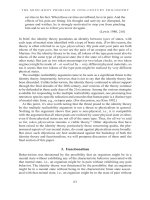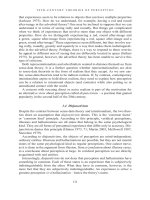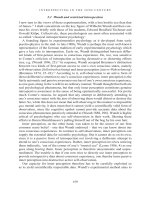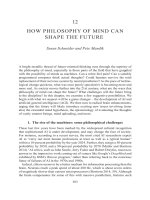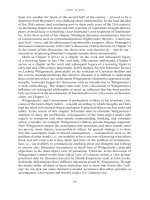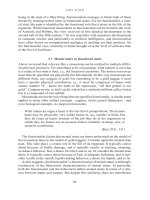Philosophy of mind in the twentieth and twenty first centuries the history of the philosophy of mind volume 6 ( PDFDrive ) (1) 82
Bạn đang xem bản rút gọn của tài liệu. Xem và tải ngay bản đầy đủ của tài liệu tại đây (171.7 KB, 1 trang )
T he mind - body problem in 2 0 th - century philosophy
cavities in his feet. When these cavities are inflated, he is in pain. And the
effects of his pain are fitting: his thought and activity are disrupted, he
groans and writhes, he is strongly motivated to stop you from pinching
him and to see to it that you never do again.
(Lewis 1980, 216)
In brief, the identity theory postulates an identity between types of states, with
each type of mental state identified with a type of brain state. (For this reason, the
theory is often referred to as type physicalism). My pain and your pain are both
tokens of the type pain, but so too are the pain of an octopus and the pain of a
Martian. For the identity theory to be true, all tokens of the type pain must also be
tokens of the same type of physical state (be it the state of c-fiber firing or some
other state). But just as two token mousetraps (or two token clocks, or two token
engines) might be made of – or realized by – very different physical materials, so
too it seems that two tokens of the type pain might be realized by very different
physical states.
The multiple realizability argument came to be seen as a significant threat to the
identity theory. Importantly, however, that is not to say that the identity theory has
been discarded. Unlike behaviorism, the identity theory continued to attract support
through the final decades of the 20th century, and versions of the theory continue
to be defended in these early days of the 21st century. Among the various strategies
available for responding to the multiple realizability argument, one promising line
retreats to species-specific reduction and concedes that human pain is a distinct type
of mental state from, e.g., octopus pain. (For discussion, see Kim 1992.)
At this point, it’s also worth noting that the threat posed to the identity theory
by the multiple realizability argument is not a threat to physicalism in general.
Nothing in the argument shows that pain is non-physical, i.e., it is compatible
with the argument that all token pains are realized by some physical state or other,
even if those physical states are not all of the same type. Thus, for all we’ve said
so far, token physicalism remains a viable theory.13 Other objections that have
been raised to the identity theory, particularly those concerning qualia, the phenomenal aspects of our mental states, do count against physicalism more broadly.
But since such objections are best understood against the backdrop of both the
identity theory and functionalism, we will postpone discussion of them until the
final section of this paper.
3. Functionalism
Behaviorism was threatened by the possibility that an organism might be in a
mental state without exhibiting any of the characteristic behavior associated with
that mental state, i.e., an organism might be in pain without exhibiting any pain
behavior. The identity theory was threatened by the possibility that an organism
might be in a mental state without being in the characteristic brain state associated with that mental state, i.e., an organism might be in the state of pain without
63

